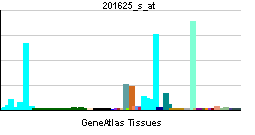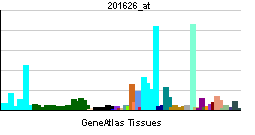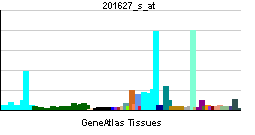INSIG1
Jump to navigation
Jump to search
| Insulin induced gene 1 | |||||||||
|---|---|---|---|---|---|---|---|---|---|
| Identifiers | |||||||||
| Symbols | INSIG1 ; CL-6; MGC1405 | ||||||||
| External IDs | Template:OMIM5 Template:MGI HomoloGene: 4047 | ||||||||
| |||||||||
| RNA expression pattern | |||||||||
 | |||||||||
 | |||||||||
 | |||||||||
| More reference expression data | |||||||||
| Orthologs | |||||||||
| Template:GNF Ortholog box | |||||||||
| Species | Human | Mouse | |||||||
| Entrez | n/a | n/a | |||||||
| Ensembl | n/a | n/a | |||||||
| UniProt | n/a | n/a | |||||||
| RefSeq (mRNA) | n/a | n/a | |||||||
| RefSeq (protein) | n/a | n/a | |||||||
| Location (UCSC) | n/a | n/a | |||||||
| PubMed search | n/a | n/a | |||||||
Insulin induced gene 1, also known as INSIG1, is a human gene.[1]
Oxysterols regulate cholesterol homeostasis through liver X receptor (LXR) and sterol regulatory element-binding protein (SREBP) mediated signaling pathway. This gene is an insulin-induced gene. It encodes an endoplasmic reticulum (ER) membrane protein that plays a critical role in regulating cholesterol concentrations in cells. This protein binds to the sterol-sensing domains of SREBP cleavage-activating protein (SCAP) and HMG CoA reductase, and is essential for the sterol-mediated trafficking of the two proteins. Alternatively spliced transcript variants encoding distinct isoforms have been observed.[1]
References
Further reading
- Peng Y, Schwarz EJ, Lazar MA; et al. (1997). "Cloning, human chromosomal assignment, and adipose and hepatic expression of the CL-6/INSIG1 gene". Genomics. 43 (3): 278–84. doi:10.1006/geno.1997.4821. PMID 9268630.
- Kaneda A, Kaminishi M, Nakanishi Y; et al. (2002). "Reduced expression of the insulin-induced protein 1 and p41 Arp2/3 complex genes in human gastric cancers". Int. J. Cancer. 100 (1): 57–62. doi:10.1002/ijc.10464. PMID 12115587.
- Yang T, Espenshade PJ, Wright ME; et al. (2002). "Crucial step in cholesterol homeostasis: sterols promote binding of SCAP to INSIG-1, a membrane protein that facilitates retention of SREBPs in ER". Cell. 110 (4): 489–500. PMID 12202038.
- Yabe D, Brown MS, Goldstein JL (2002). "Insig-2, a second endoplasmic reticulum protein that binds SCAP and blocks export of sterol regulatory element-binding proteins". Proc. Natl. Acad. Sci. U.S.A. 99 (20): 12753–8. doi:10.1073/pnas.162488899. PMID 12242332.
- Janowski BA (2002). "The hypocholesterolemic agent LY295427 up-regulates INSIG-1, identifying the INSIG-1 protein as a mediator of cholesterol homeostasis through SREBP". Proc. Natl. Acad. Sci. U.S.A. 99 (20): 12675–80. doi:10.1073/pnas.202471599. PMID 12242342.
- Strausberg RL, Feingold EA, Grouse LH; et al. (2003). "Generation and initial analysis of more than 15,000 full-length human and mouse cDNA sequences". Proc. Natl. Acad. Sci. U.S.A. 99 (26): 16899–903. doi:10.1073/pnas.242603899. PMID 12477932.
- Yabe D, Xia ZP, Adams CM, Rawson RB (2003). "Three mutations in sterol-sensing domain of SCAP block interaction with insig and render SREBP cleavage insensitive to sterols". Proc. Natl. Acad. Sci. U.S.A. 99 (26): 16672–7. doi:10.1073/pnas.262669399. PMID 12482938.
- Sever N, Yang T, Brown MS; et al. (2003). "Accelerated degradation of HMG CoA reductase mediated by binding of insig-1 to its sterol-sensing domain". Mol. Cell. 11 (1): 25–33. PMID 12535518.
- Scherer SW, Cheung J, MacDonald JR; et al. (2003). "Human chromosome 7: DNA sequence and biology". Science. 300 (5620): 767–72. doi:10.1126/science.1083423. PMID 12690205.
- Dobrosotskaya IY, Goldstein JL, Brown MS, Rawson RB (2003). "Reconstitution of sterol-regulated endoplasmic reticulum-to-Golgi transport of SREBP-2 in insect cells by co-expression of mammalian SCAP and Insigs". J. Biol. Chem. 278 (37): 35837–43. doi:10.1074/jbc.M306476200. PMID 12842885.
- Li J, Takaishi K, Cook W; et al. (2003). "Insig-1 "brakes" lipogenesis in adipocytes and inhibits differentiation of preadipocytes". Proc. Natl. Acad. Sci. U.S.A. 100 (16): 9476–81. doi:10.1073/pnas.1133426100. PMID 12869692.
- Adams CM, Goldstein JL, Brown MS (2003). "Cholesterol-induced conformational change in SCAP enhanced by Insig proteins and mimicked by cationic amphiphiles". Proc. Natl. Acad. Sci. U.S.A. 100 (19): 10647–52. doi:10.1073/pnas.1534833100. PMID 12963821.
- Feramisco JD, Goldstein JL, Brown MS (2004). "Membrane topology of human insig-1, a protein regulator of lipid synthesis". J. Biol. Chem. 279 (9): 8487–96. doi:10.1074/jbc.M312623200. PMID 14660594.
- Ota T, Suzuki Y, Nishikawa T; et al. (2004). "Complete sequencing and characterization of 21,243 full-length human cDNAs". Nat. Genet. 36 (1): 40–5. doi:10.1038/ng1285. PMID 14702039.
- Engelking LJ, Kuriyama H, Hammer RE; et al. (2004). "Overexpression of Insig-1 in the livers of transgenic mice inhibits SREBP processing and reduces insulin-stimulated lipogenesis". J. Clin. Invest. 113 (8): 1168–75. doi:10.1172/JCI200420978. PMID 15085196.
- Sever N, Lee PC, Song BL; et al. (2004). "Isolation of mutant cells lacking Insig-1 through selection with SR-12813, an agent that stimulates degradation of 3-hydroxy-3-methylglutaryl-coenzyme A reductase". J. Biol. Chem. 279 (41): 43136–47. doi:10.1074/jbc.M406406200. PMID 15247248.
- Lee JN, Ye J (2004). "Proteolytic activation of sterol regulatory element-binding protein induced by cellular stress through depletion of Insig-1". J. Biol. Chem. 279 (43): 45257–65. doi:10.1074/jbc.M408235200. PMID 15304479.
- Gerhard DS, Wagner L, Feingold EA; et al. (2004). "The status, quality, and expansion of the NIH full-length cDNA project: the Mammalian Gene Collection (MGC)". Genome Res. 14 (10B): 2121–7. doi:10.1101/gr.2596504. PMID 15489334.
- Suchanek M, Radzikowska A, Thiele C (2005). "Photo-leucine and photo-methionine allow identification of protein-protein interactions in living cells". Nat. Methods. 2 (4): 261–7. doi:10.1038/nmeth752. PMID 15782218.
- Sun LP, Li L, Goldstein JL, Brown MS (2005). "Insig required for sterol-mediated inhibition of Scap/SREBP binding to COPII proteins in vitro". J. Biol. Chem. 280 (28): 26483–90. doi:10.1074/jbc.M504041200. PMID 15899885.
| This protein-related article is a stub. You can help Wikipedia by expanding it. |